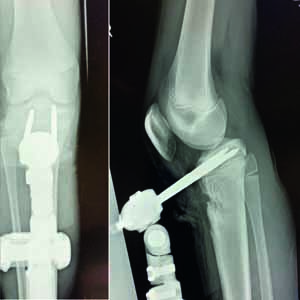Acquired genu recurvatum in a skeletally immature patient treated by physeal distraction: A case report

Published: 28 October 2022
Abstract Views: 472
PDF: 294
Publisher's note
All claims expressed in this article are solely those of the authors and do not necessarily represent those of their affiliated organizations, or those of the publisher, the editors and the reviewers. Any product that may be evaluated in this article or claim that may be made by its manufacturer is not guaranteed or endorsed by the publisher.
All claims expressed in this article are solely those of the authors and do not necessarily represent those of their affiliated organizations, or those of the publisher, the editors and the reviewers. Any product that may be evaluated in this article or claim that may be made by its manufacturer is not guaranteed or endorsed by the publisher.
Similar Articles
- Elisabetta Villa, Roberta Barachetti, Mario Barbarini, Nutritional management of preterm newborn after hospital discharge: energy and nutrients , La Pediatria Medica e Chirurgica: Vol. 39 No. 4 (2017)
- Antonio Marte, Lucia Pintozzi, Tubularized proximally-incised plate in distal/midshaft hypospadias repair , La Pediatria Medica e Chirurgica: Vol. 39 No. 2 (2017)
- Sally K. I. Ishak, Fayrouz El Aguizy, Eman H. Elsebaie, Meray R. L. Youssef, Mohamed M. Ismail, Fatma H. Abdelraouf, Heba A. Abdel Ghaffar, Nermine M. Riad, Role of urinary NGAL and microalbuminuria in the detection of subclinical acute kidney injury in pediatric intensive care unit and diabetic children , La Pediatria Medica e Chirurgica: Vol. 44 No. 2 (2022)
- Valentina Bozzetti, Paolo E. Tagliabue, Enteral feeding of intrauterine growth restriction preterm infants: theoretical risks and practical implications , La Pediatria Medica e Chirurgica: Vol. 39 No. 2 (2017)
- Gianluca Lista, Fabio Meneghin, Ilia Bresesti, Francesco Cavigioli, Nutritional problems of children with bronchopulmonary dysplasia after hospital discharge , La Pediatria Medica e Chirurgica: Vol. 39 No. 4 (2017)
- Massimo Agosti, Francesco Tandoi, Laura Morlacchi, Angela Bossi, Nutritional and metabolic programming during the first thousand days of life , La Pediatria Medica e Chirurgica: Vol. 39 No. 2 (2017)
- Sara Uccella, Agnese De Carli, Ida Sirgiovanni, Paola Schiavolin, Giuseppe Damiano, Beatrice Ghirardi, Francesca Maglioli Carpano, Laura Bassi, Silvana Gangi, Odoardo Picciolini, Monica Fumagalli, Fabio Mosca, Survival rate and neurodevelopmental outcome of extremely premature babies: an 8-year experience of an Italian single neonatal tertiary care center , La Pediatria Medica e Chirurgica: Vol. 37 No. 3 (2015)
- Agostino Berio, Giacomo Garlaschi, Giuseppe Mangiante, Attilia Piazzi, Oculo-auriculo-vertebral spectrum with craniosynostosis and osteo-cartilagineous multiple defects: a diffuse chondro-membranous-osteo-dysplasia , La Pediatria Medica e Chirurgica: Vol. 37 No. 3 (2015)
- Valentina Bozzetti, Paolo E. Tagliabue, Enteral nutrition for preterm infants: by bolus or continuous? An update , La Pediatria Medica e Chirurgica: Vol. 39 No. 2 (2017)
- Luisella Pedrotti, Barbara Bertani, Gabriella Tuvo, Redento Mora, Luca Marin, Federica De Rosa, Achilles tendon surgery in clubfoot: Are long term sequelae predictable? , La Pediatria Medica e Chirurgica: Vol. 44 No. 1 (2022)
You may also start an advanced similarity search for this article.

 https://doi.org/10.4081/pmc.2022.294
https://doi.org/10.4081/pmc.2022.294




